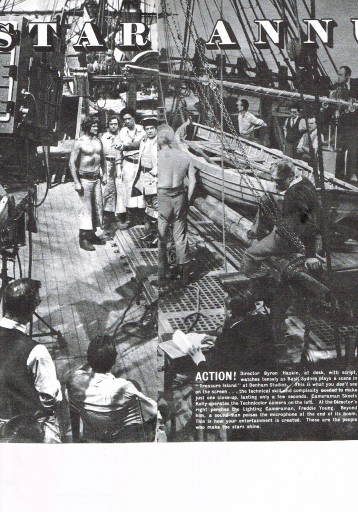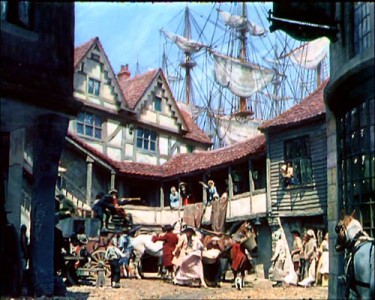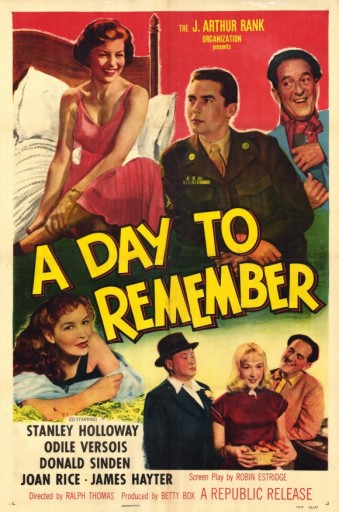Sunny and self-assured, Rosalyn Boulter seems an unlikely lady of mystery. She is the perfect no-nonsense foil for George Formby in his final film, George in Civvy Street in 1946.
Rosalyn plays Mary Colton, George’s childhood sweetheart. When George returns from the war, he finds that both he and Mary have inherited their fathers’ rival pubs. She owns (but is too young to run) the Lion, across a canal from George’s Unicorn. We may wonder, of course, where she got her posh accent in a Lancashire village, but the fair-haired, feisty Mary is more than a match for the requisite villain who seeks her inheritance, her hand, and George’s downfall.
When she learns of the villainy afoot and tries to warn George, Mary is locked up. No shy violet, she overpowers her jailer, swims the canal, and even strips to her undies (or less) behind a convenient blanket. To balance all this athletic eroticism, she then appears as a demure Alice in Wonderland to George’s Mad March Hare in a dream sequence. A dynamic post-war woman played by an actress of considerable talent!
George sings ‘It’ll Make you Madder than the Mad March Hare’
Fair-haired Rosalyn Boulter was born in Burton-on-Trent, Staffordshire, on February 1, 1916, the daughter of Arthur Edward Boulter and his wife, Lillian (Douthwaite). Rosalyn attended the North Middlesex School and then studied for the stage at the Central School of Speech Training and Dramatic Art under Elsie Fogerty.
Her first professional appearance was at age 19 at the Arts Theatre Club on June 11, 1935, playing Lady Clive in Clive of India. That summer she had important roles in A Midsummer Night’s Dream (as Hermia) and Love’s Labour’s Lost at the Regents Park Open Air Theatre. (The following summer she returned for As You Like It and The Tempest.)
Her career took off quickly, bringing both stage and film roles. She was featured in 4 West End productions in 1935 and 1936. Her first 2 film roles, a romantic comedy called Love at Sea (1936) and Holiday’s End (1937), a thriller, gave her top billing. In 1937, she toured the U.K. and made her Broadway debut, playing the ingenue lead in the West End hit George and Martha.
Rosalyn married Stanley Haynes, a film writer, director, producer, and, according to one friend, “charming philanderer.” They had a daughter, Carol, in 1942 or 1943. Rosalyn remained active in films during this time, appearing in 1942 with Leslie Howard, David Niven, and Anne Firth (another Formby leading lady) in The First of the Few (aka Spitfire), a stirring biography of R.J. Mitchell, designer of the Spitfire airplane. In 1943, she made two wartime propaganda films, The Gentle Sex, about women doing war work, and Rhythm Serenade, a Vera Lynn vehicle.
Back in the West End, she starred with Barry Morse in The Assassin in 1945. A fellow performer recalls impressing his girlfriend by taking her to the splendid opening night party at the Savoy which was attended by Noël Coward and other celebrities. There, the young lady was introduced to Boulter’s husband, Stanley Haynes, and “two weeks later, he buggered off with my girlfriend!” Apparently, this marked the end of Boulter’s first marriage. Devastated, she remained with her daughter Carol in the family home at 2 Gloucester Walk in Kensington, London, getting emotional support from friends that included Marcel Varnel (a Formby director) and fellow actors Derrick de Marney and Richard Neilson.
1946 represented both a peak in Rosalyn’s career and a major disappointment. Every actor knows how the right role at the right time can make a star. On stage, Rosalyn had scored a major triumph as the unscrupulous and faithless wife of a man driven to murder in Dear Murderer. However, the film, starring Eric Portman and Dennis Price, used Greta Gynt in Boulter’s role. Then her luck changed — or so she thought.
Rosalyn Boulter appeared in Richard Todd’s very first film ‘For Them That Trespass’ Directed by Alfredo Cavalcanti
She was cast in the key role of Burgess Meredith’s mistress in the film Mine Own Executioner. Unfortunately, Meredith’s wife, Paulette Goddard, was also in England, filming Oscar Wilde’s An Ideal Husband for Alexander Korda. Goddard decided that Rosalyn wasn’t sexy enough for the part and was instrumental in having her replaced by Korda’s current protegée, Christine Norden, a voluptuous green-eyed blonde who was playing Mrs. Marchmont in The Ideal Husband. Norden’s highly sensual performance as the mistress in Mine Own Executioner helped to establish her as the first postwar sex symbol of the British cinema, prior to the ascendancy of Diana Dors. So memorable was Norden’s performance that, after her death in 1988, part of the planet Venus was named for her!
Rosalyn was bitter about this loss for many years, feeling it blighted her career. Norden, aware of Boulter’s feelings, said in later years, “She blames me to this day, but I was under contract and simply did as I was told.”
On August 8, 1952 in London, Rosalyn married Joseph Sistrom, an American film producer (Double Indemnity, Botany Bay). A newspaper account described the happy couple accompanied by Rosalyn’s pretty, blonde daughter, Carol, then age 9. Rosalyn made only one more film, The Day They Gave Babies Away in 1959, and then her private life becomes something of a mystery.
According to one friend, she never remarried after Sistrom’s death in 1966. But another, actor Richard Neilson, recalls being introduced that year to Rosalyn’s husband William Dozier, “a prominent Hollywood producer with Universal….in a luxury high-rise in Greenwich Village. They later lived on a turkey ranch in Arizona.” William Dozier (1908-1991) was a Vice President at RKO Studios and later a CBS-TV executive.
“Ros was going on the road with some show,” recalls Neilson, “and I loaned her a rather beautiful — what we called in those far off days — wardrobe trunk, white leather, very posh. I had a few cards over the next months. Then Rosalyn — and my trunk — went out of my life.” (If indeed she did a U.S. road tour in the 1960s, this would indicate that Rosalyn remained active in the theatre well beyond Waggonload O’ Monkeys in 1951, her final, officially-logged U.K. stage appearance.)
Rosalyn Boulter died on March 6, 1997 in Santa Barbara, California. Her death certificate lists her Rosalyn Boulter Sistrom, indicating that either she never remarried after Joseph Sistrom’s death, or alternately, that she returned to his name after William Dozier’s death. To further muddle things, some sources recall that she married William Sistrom, a British film director (whose wives included Joan Fontaine and Ann Rutherford), but this clearly is not the case. Perhaps a mental merging of Joseph Sistrom and William Dozier?
(The obituaries for neither William Sistrom nor William Dozier mention Rosalyn.)
Whatever her professional activities after her final film in 1959, Rosalyn Boulter deserves being remembered in the various biographical performing arts anthologies, both for her more than 20 years in show business with 12 films and 23+ stage appearances, and also for her obvious beauty and charm.
Real life, like reel life, can offer melodramatic twists and surprise endings. Some of the George Formby leading ladies went on to well-documented fame. Others retired from performing, making it a challenge to locate them or find information about their later years.
One of the most elusive has been Rosalyn Boulter, who, despite extensive stage and screen credits, seemed to vanish when she left acting. No obituary has been found. Even a group of hardy scholars devoted to tracking the birth/marriage/death dates of obscure UK actors could not find a trace of her.
During several years of networking, I located two longtime Boulter friends. Both told me that Rosalyn Boulter had died “some years ago” in the United States — one thought in California, the other on a ranch in Arizona. They also differed on the name of her last husband. (Given the fallibility of human memory, it is a wonder that eyewitness testimony is ever permitted in court!)
Enter a recent boon for researchers: the on-line U.S. Social Security Death Index. As a matter of public record, it lists birth and death information for everyone with a U.S. Social Security number who has died since 1960. (Presumably earlier S.S. records will be added, back to its inception in 1933.) By checking maiden and all possible married names, I found that “Rosalyn Sistrom” died on March 6, 1997 in Santa Barbara, California. This was just 17 months before I was assured by good friends that she had been dead for a decade or two.
I sent for a copy of her probated will, another public document that could reveal the names and addresses of relatives or friends. However, another mini-mystery: her will wasn’t probated in the county where she died. Nor have I been able to determine if her daughter Carol (who would now be about 58) is still alive.
A poignant and probably fanciful explanation has occurred to me. Did Rosalyn suffer a stroke or incapacitating illness and enter a nursing facility several decades ago? Did her east-coast friends, having their Christmas cards returned and discovering her phone disconnected, decide that she must have died? And did she spend her final years alone and cut off from her old friends until her death in 1997? Or is there a simpler and less melodramatic explanation, such as a failure of the post office to forward letters?
Carol Haynes, if you are out there, we would love to know more about your lovely mother’s life after she left the spotlight.
POSTSCRIPT:
In the Spring, 2001 Vellum profile of Rosalyn Boulter, George’s sunny leading lady in George In Civvy Street, 1946, much of Rosalyn’s later life had evaded the author’s research efforts, making her something of a mystery lady.” But once the article was posted on the George Formby Society web site, a genealogical researcher in East Suffolk, Denis Sistrom, contacted the GFS to correct some errors [See Letters] and to put us in touch with Carol Johnson, Rosalyn’s only daughter. Here is a follow-up interview with Carol about the post-1952 life of her mother, Rosalyn Boulter.
Carol Haynes Johnson is the daughter of Rosalyn and film director-writer-producer Stanley Haynes. Their marriage broke up when Carol was quite young. “Daddy came into our lives when I was about 4,” she recalls,
referring to her step-father William Sistrom. “He was gentle, loving, giving. I always called him ‘Daddy.'”
Rosalyn married her second husband, William “Billy” Sistrom, in London on August 8, 1952 when Carol was 8. Sistrom was 68, Rosalyn 36. (Some newspaper accounts confused English-born William with his American-born sons, William and Joseph. Rosalyn’s Vellum profile erroneously reported that the groom was Joseph.)
As a child, Carol played with Jeremy and Jennifer Hanley, children of Dinah Sheridan (leading lady of Get Cracking) and actor Jimmy Hanley. Carol has a wonderful photo of the 3 of them watching their parents on stage.
Billy Sistrom had produced 30 UK and US films between 1930 and 1949, including Dangerous Moonlight, A Dog Of Flanders, and Hungry Hill. After the marriage, he retired, and the family moved to Phoenix, Arizona. “It’s a dreadful memory for me, such a contrast between the desert of Phoenix and the green of England,” recalls Carol. Billy Sistrom managed a turkey ranch in Buckeye, about 40 miles outside the city.
Rosalyn worked with the Phoenix Little Theater, directing, acting, and producing 4 or 5 shows a year. She starred in a highly acclaimed production of Johnny Belinda for which she learned American sign language. The group frequently presented Shakespearean plays, and Rosalyn appeared in Othello (as Desdemona), Hamlet (as Ophelia), and Macbeth (as Lady MacBeth) — an extraordinary range for any one actress.
“The joke in the family to this day,” says Carol, “is that I have never read Shakespeare. Whenever a play was assigned in school, I’d ask mother to do it on stage so I could watch her do it and then report on it. I loved watching the plays, but not reading them. Which is odd because I’m a voracious reader.”
Carol appeared on stage only once as a child, a small role in a Phoenix Little Theatre production The Remarkable Mr. Pennypacker. She was not tempted to seek an acting career: “When you’ve watched perfection like my mother, it’s very intimidating.”
The “extraordinarily happy” couple had often talked of moving to Santa Barbara on the coast of California. Then Billy Sistrom died in 1972 in Arizona at the age of 88. Carol had already married Bill Johnson (“who also loves animals”) and moved to Texas. (They now live in Louisiana. Carol has a granddaughter and 3 grandsons.)
In 1975, Rosalyn made the move alone to Santa Barbara. “Mother was extraordinarily happy there,” recalls Carol. “She lived near the beach in a lovely home and had lots of friends.” Rosalyn got involved with the Lobero Theatre, connected to the University of California, Santa Barbara. She soon switched over from acting to behind-the-scenes activities. She was very active in fund raising and did benefits with people like Vincent Price, Dame Judith Anderson, Robert Mitchum, Jane Russell, and Jimmy Stewart.
Above – Lobero Theatre Santa Barbara
Nearing the age of 80, Rosalyn developed macular degeneration which caused her eyesight to fail. Carol came to stay with her during the final 9 months of her life. “I’m so grateful that we had that time together.” Rosalyn went into the hospital for a fairly routine surgical procedure to remove plaque from an artery. The next day, she was chatting cheerfully with a dear friend when she collapsed unexpectedly and died of a blood clot.
A memorial service was held at the Lobero Theatre, attended by many of the celebrated performers she had known and worked with over the years. At the end of the service, actress Anne Francis stood and said, “Let’s give a hand for this great lady.” Everyone rose and gave a round of applause.
Carol recalls that her mother “had a fantastic sense of humour and loved to laugh. She was an incredible woman, very loving, very kind. She is terribly missed.” Eleanor Knowles Dugan
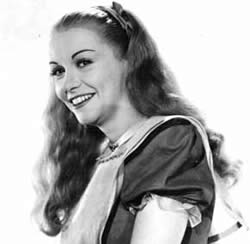
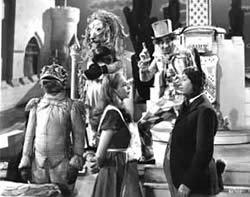
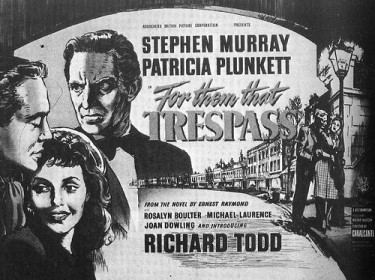

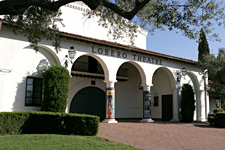

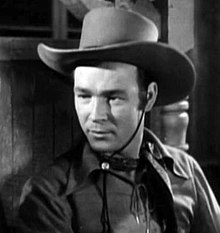


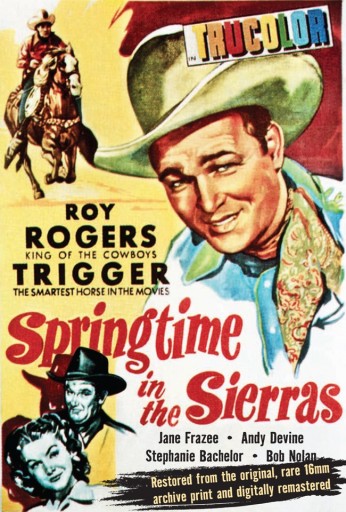
![MOV_e6a63591_b[1]](http://filmsofthefifties.com/wp-content/uploads/2013/04/MOV_e6a63591_b1-375x293.jpg)


